Support
Dear Friends and Fans of Tall Hisban
All who have had the privilege of hiking to the summit of Tall Hisban in Jordan can attest to its magnificent panoramic view. I have personally spent hours on top of this ancient ruin savoring its glorious vistas. Westward are the magnificent views of. Mount Nebo and the Jordan Valley, Jericho and the West Bank, Jerusalem and Ramallah. Northward, are the biblical tall of El Al and the Ammonite hill country. South and eastward are the fertile plains and verdant valleys that extend toward Madaba and the Moabite table land.
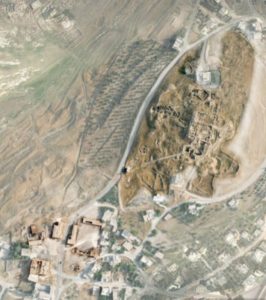
Google Earth view of the archaeological site of Tall Hisban and the Nabulsi stables and qasr.
It is no wonder that Tall Hisban, towering above the surrounding landscape at 885 meters above sea level, has been a height to conquer and defend by local strongmen and ambitious tribal kings and even by the resident proxies of distant emperors. Evidenced in the archaeological discoveries from Tall Hisban are the footprints ofa long line of conqueringpeoples including those of the ancient Amorites, Israelites, Ammonites, Moabites, Assyrians, Persians, Greeks, Romans, Byzantines, Umayyads, Abbasids, Ayyubids, Mamluks and Ottomans.
This multi-millennial tale of conquest by kings and emperors and of staunch survival by locals that is the “big story” of Tall Hisban is a story that many of you reading this post helped unearth as part of the original Heshbon Expedition led between 1968 and 1976 by Siegfried H. Horn, Roger Boraas and Lawrence T. Geraty, or as a member of the Phase II Tall Hisban Excavations led between 1997 and 2013 by myself and Bethany Walker, or as a sponsor-supporter of one of these expeditions. As you may already know, a short film about our current fieldwork and most recentefforts to narrate the “big story” of Tall Hisban can be found on YouTube and Vimeo – when you search for “Deep Time at Tall Hisban.” A complete list of all of our scholarly publications can be found at our web site.
This post serves two purposes: the first is to let you know of efforts currently underway to provide for a sustainable future for the archaeological site of Tall Hisban itself, and the second is to tell you of plans underway to establish a Visitor Center in the abandoned stables and guest house (qasr) which is also known as the Nabulsi complex. Below I describe how we plan to provide apprenticeships for young men and women from Tall Hisban in order to restore these buildings using traditional methods of construction while also providing much valued employment and training to these young people. So yes, this is also an appeal inviting you to consider becoming a sponsor of this undertaking!
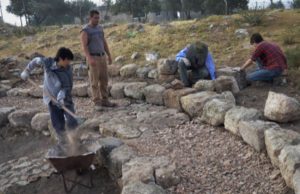
Stanley Beikmann and three of his landscape design students at work building a welcoming area near the entrance to the tall.
Over the past decade we have taken many steps to make Tall Hisban a truly memorable place for tourists to visit. A key step in this effort has been to make thesite more comprehensible. For example, we have cleaned the Iron Age reservoir, exposed and restored the Hellenistic perimeter wall and towers, consolidated the northern wall of the Roman temple, raised three columns in the Byzantine church, repaired the Islamic bath house and excavated and partially re-built the Mamluk governors’ headquarters.
With the help of Stanley Beikmann of the Department of Agriculture at Andrews and a team of his landscape design students, we have sought to make visits to the site not only more memorable and educational, but also safer and easier to navigate. To this end, Beikmann and his team designed and installed a circular pathway that takes the visitor along a path that passes by all the major archaeological features of the site and that includes several viewing platforms and a total of 36 interpretive signs. They also designed and added a new welcoming area near the entrance to the site which includes a small interpretive garden explaining some of the different types of plants that have been a part of the lives of Hisbanites since ancient times. Here the two parallel stories of power and imperial domination and of resourceful survival by locals can be explained to visitors comfortably seated in rows of seats arranged like a small amphitheater around the interpretive garden.
Most important, perhaps, we have partnered with the local municipality and families of Hisban in our efforts to protect the site from looting and keep it presentable for visitors! This initiative to engage the local community in helping to take care of the site is one more way that our team has pioneered best practices in cultural heritage preservation in Jordan. This approach has since been adopted by many other projects in Jordan, including Petra!
Furthermore, these efforts to turn what had become a treacherous mound of collapsing excavation holes and scattered stone heaps into a well-planned archaeological park for local families and foreign tourists to visit and enjoy, along with our efforts to partner with the local community in caring for and looking after the site, has been noticed by key members of the Nabulsi family, owners of a cluster of large farm buildings located about 200 meters from the entrance to the tall.
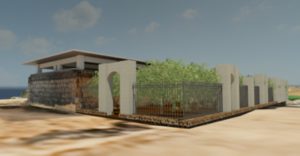
Design proposal by Jason Blanzy, Martin Smith and Stanley Beikmann for a Hall of Landscape and Agricultural History
As these farm buildings are now no longer being used by the family, the Nabulsis have offered to make them available to ourarchaeological team to lead out in restoring and turning them into a visitor center. Their stipulation is that, as far as possible, the buildings be restored to their original appearance using traditional building methods and that the activities that take place in these buildings will be a source of employment and income generation for the present-day residents of Hisban. To this end, Jason Blanzy and Martin Smith of the School of Architecture have drawn up a Master Plan laying out our vision for restoring the entire Nabulsi complex.
Admittedly, the effort it will take to restore even one of these buildings will be significant, to say the least—but we are convinced that it can be done. There are several reasons for this confidence. The first is that we plan to focus on one building at a time, starting with Building A, the Hall of Landscape and Agricultural History, learning lessons as we go and applying these as we proceed to the next.
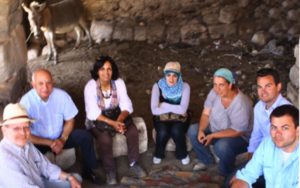
Planning meeting with Dr. Safa Nabulsi in one of the heritage building belonging to his family.
Second, we have shared our Master Plan with key local authorities such as the Municipality of Hisban and the Department of Antiquities of Jordan and have been assured of their support as we move forward with implementation. We have also discussed it with the Director of the Madaba Office of the Ministry of Agriculture who is especially happy to see us emphasize in Building A the region’s agricultural history and has offered the assistance of his ministry as we proceed with implementing the project.
The third reason for our confidence is our many years of mutually beneficial collaboration with the local residents of Hisban which now span three generations. When it comes to hiring men and women to help with the various skilled and unskilled tasks that will be required to restore each building we will be counting on these same families to be our partners. With this reconstruction project, we also plan to include a significant on-the-job training component as we proceed.
For example, we plan to hire master craftsmen from Hisban and nearby towns to provide training in documenting, building and restoring structures using traditional building techniques and historically accurate lime mortars to consolidate the walls of these heritage buildings and related installations such as courtyards, caves and cisterns. This training will be mostly hands-on as the master craftsmen and their apprentices work side-by-side to restore each building. And, as a bonus to make this training even more worthwhile for our apprentices, we will offer opportunities for them to improve their English skills and our students will have an opportunity for learning some Arabic too.
In fact, another key component of our strategy for implementing this master plan is the Jordan Field School which will continue to bring Andrews professors and students to Jordan on an annual basis to work with the local craftsmen and their apprentices in doing restoration work, and to assist with preparing and installing exhibits for the various buildings. To this end, Jason Blanzy has been appointed to serve as project manager in charge of overseeing the work of the master craftsmen and their apprentices and for preparing for the work to be done by the students from Andrews during our field season. In 2014, it will take place from May 23 to June 16. Jason will work closely with Elena Ronza, co-director of the Hisban Cultural Heritage Project.
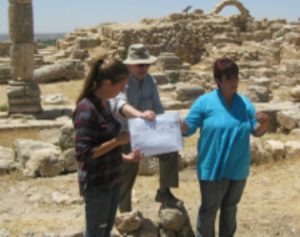
Anastasia presenting proposal for socio-economic garden
However, we are not the only educational institution that will be involved in carrying forward the vision outlined in our Master Plan. Other institutional partners with whom we have already begun to collaborate include the Department of Architecture and Cultural Heritage at the German-Jordanian University near Hisban; the Department of Islamic Studies at the University of Bonn in Germany; and the Department of History at Oklahoma State University. The latter two connections have been brought on-board by Bethany Walker who has recently assumed the role of Director of Archaeological Excavations at Tall Hisban. We have also recently been contacted by faculty from the elite King’s Academy near Madaba asking about ways that they might become involved with this project.
The Hisban Planned Giving Project aims to raise $50,000 per year over the next five years. We would warmly welcome your participation at whatever level you are able: 200 dollars, 2000 dollars, or 20,000 dollars. These funds will be used to pay for 40 weeks of full-time work per year by our project manager, two master craftsmen, and ten apprentices. Over the period of five years we aim to train and employ a minimum of 50 apprentices. In this way, we will not only provide much needed training and employment for young men and women in Hisban, but also build local capacity in heritage building restoration and preservation.
To facilitate giving to the Hisban Planned Giving Project we have set up a special fund through Andrews’ Office of Development called the Hisban Legacy Fund that will enable you to receive tax credit for any and all contributions to this project. It is also possible to send a personal check or a registered check to: Hisban Legacy Fund, c/o Donor Records Administrator, Office of Development, Andrews University, Berrien Springs, MI 49104.
Thank you ahead of time for kind consideration of this appeal!
Øystein S. LaBianca, Ph.D.
Senior Research Professor and
Senior Director, Hisban Cultural Heritage Project
Andrews University